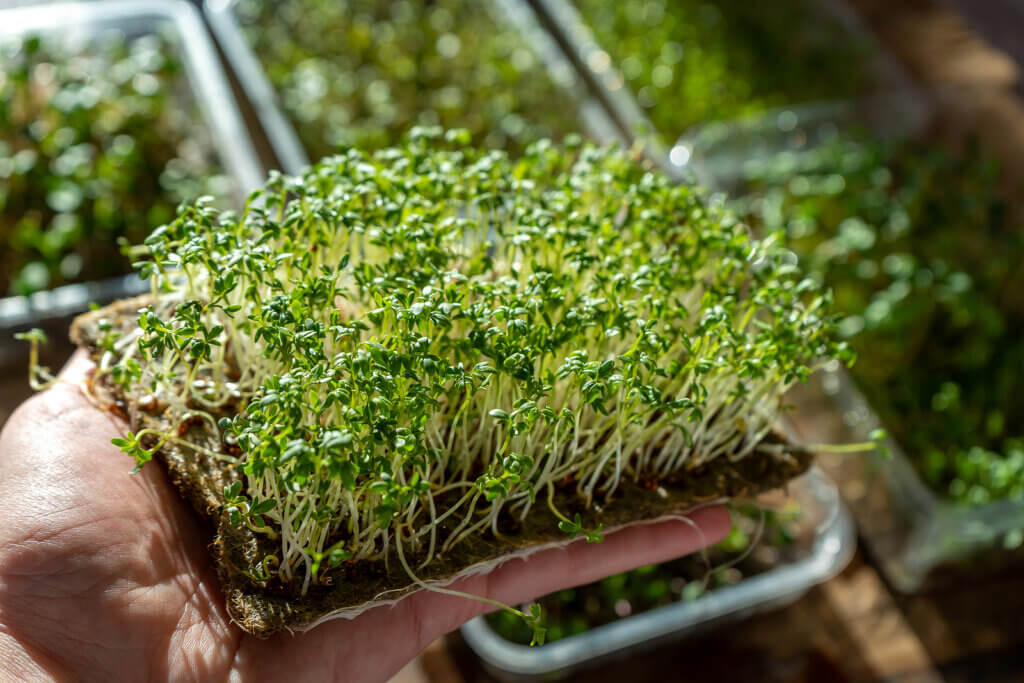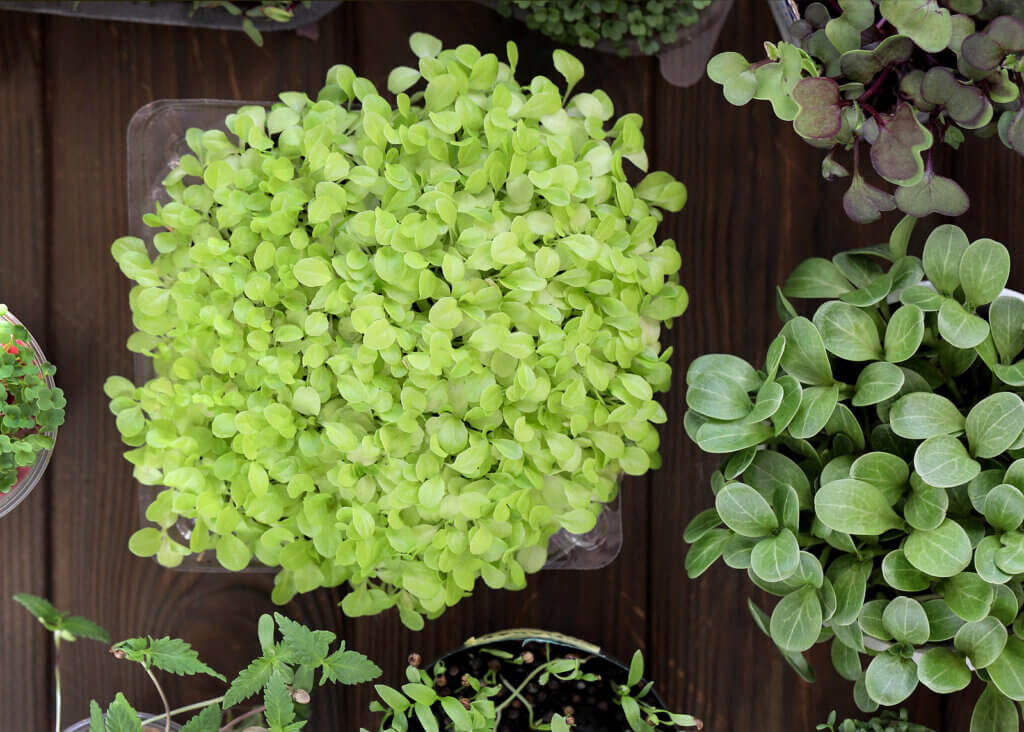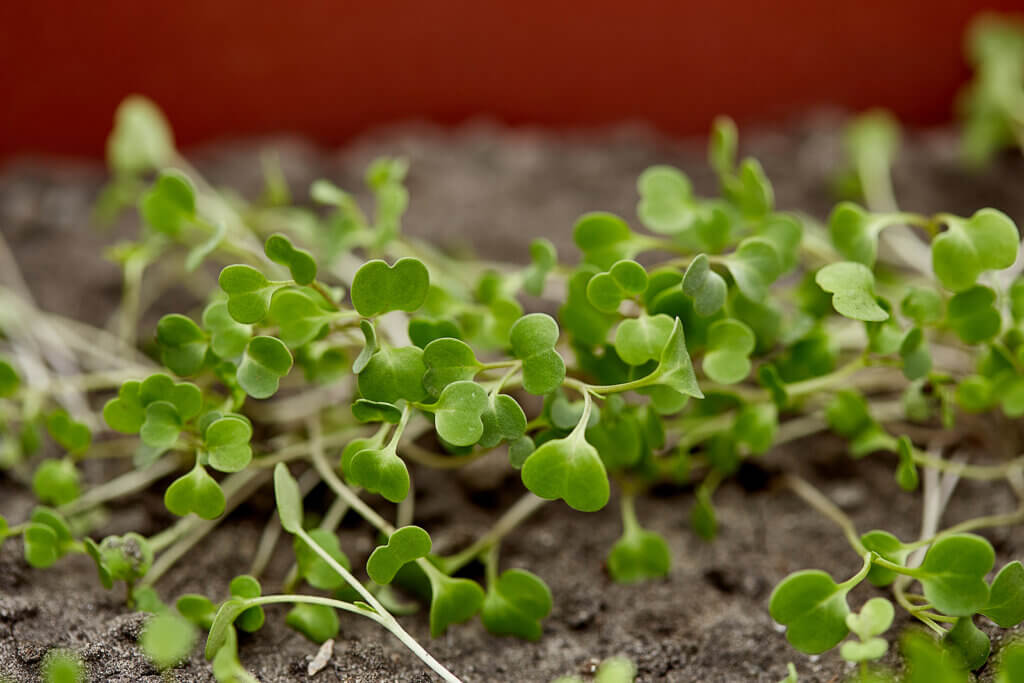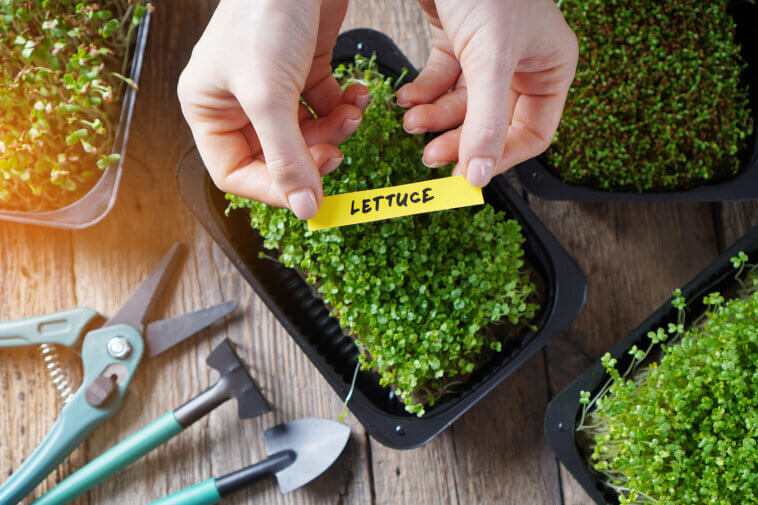Table of Contents
In recent years, I've been thrilled to witness a remarkable shift towards making healthier and more sustainable dietary choices. One culinary sensation that has truly captivated my taste buds and nutrition-conscious mind is the world of microgreens, with lettuce microgreens taking center stage. Join me on an exciting journey as we dive deep into the fascinating realm of it.
We'll explore howhow to grow lettuce microgreens at home, unravel their nutritional benefits, and unleash their culinary potential. Get ready to uncover the vibrant world of lettuce microgreens, the green goldmine that has truly enriched my culinary adventures!
What Are Lettuce Microgreens?
Lettuce microgreens are a fascinating category of miniature edible plants known as “microgreens,” often playfully referred to as “vegetable confetti” due to their tiny size and vibrant colors. These remarkable greens are harvested at an incredibly early stage of growth, typically ranging from just 7 to 21 days after germination. lettuce microgreens nutrition, in particular, belong to the broader lettuce family, which encompasses an array of varieties like butterhead, romaine, and oak leaf lettuce.
What sets lettuce microgreens apart is their unique development process. During their brief but crucial growth period, these diminutive plants quickly sprout their first true leaves. This not only enhances their visual appeal but also significantly boosts their nutritional value.
As a result, lettuce microgreens offer not only aesthetic appeal but also a dense concentration of vitamins, minerals, and antioxidants, making them a delightful addition to salads, sandwiches, and various culinary creations.
Read also our post on Microgreens Powder
The Nutritional Powerhouse of Lettuce Microgreens
Lettuce microgreens, despite their diminutive stature, wield an impressive nutritional arsenal that extends far beyond their size. These tiny greens are a treasure trove of essential vitamins, minerals, and antioxidants, contributing significantly to your overall well-being. Let's delve deeper into the remarkable nutritional attributes of lettuce microgreens seeds:
Nutrient Density
Lettuce microgreens are nutritional powerhouses, packed with a wide range of essential nutrients that offer numerous health benefits. Here's a closer look at the impressive nutrient profile of lettuce microgreens:
- Vitamin C: These tiny greens are rich in vitamin C, a crucial nutrient known for its role in bolstering the immune system, promoting collagen production for skin rejuvenation, and acting as a powerful antioxidant that fights against harmful free radicals.
- Vitamin K: Lettuce microgreens are an excellent source of vitamin K, which plays a pivotal role in blood clotting, ensuring that wounds can heal properly. Additionally, vitamin K is important for maintaining bone health by regulating calcium in the bones.
- Vitamin A: These microgreens provide a significant amount of vitamin A, which is essential for good vision, immune system support, and promoting healthy skin by stimulating cell growth and repair.
- Folate: Lettuce microgreens contain folate, a B-vitamin that is vital for DNA synthesis and cellular growth, making it particularly important during pregnancy and for overall health.
- Iron: Iron is another essential nutrient found in lettuce microgreens. It is a fundamental component of red blood cells, helping to transport oxygen throughout the body and preventing anemia.
- Calcium: Calcium is important for maintaining strong bones and teeth. While lettuce microgreens may not have as much calcium as dairy products, they still contribute to your daily calcium intake, especially when incorporated into a balanced diet.
- Magnesium: These microgreens also contain magnesium, which is involved in more than 300 biochemical reactions within the body. Magnesium plays a critical role in muscle and nerve function, blood glucose control, and maintaining healthy heart function.
Antioxidant Content
Lettuce microgreens are a treasure trove of antioxidants, including notable compounds like beta-carotene and lutein. These antioxidants serve as formidable defenders against oxidative stress and the damaging impacts of free radicals within the body. Understanding the antioxidant content of lettuce microgreens reveals how they can be a valuable addition to your diet for enhancing overall health and mitigating the risk of chronic diseases.
- Beta-Carotene: Lettuce microgreens are particularly rich in beta-carotene, a potent antioxidant and a precursor to vitamin A. Beta-carotene not only contributes to the vibrant green and red hues of these microgreens but also plays a pivotal role in neutralizing harmful free radicals. By doing so, it helps safeguard cells from oxidative damage and supports a strong immune system.
- Lutein: Another prominent antioxidant found in lettuce microgreens is lutein. Lutein is well-known for its beneficial effects on eye health, as it accumulates in the retina and acts as a natural sunblock, protecting against harmful UV rays. Moreover, lutein contributes to overall antioxidant defense, reducing the risk of chronic conditions associated with oxidative stress.
Dietary Fiber
Dietary Fiber is a vital component of a well-rounded diet, playing a pivotal role in promoting digestive health and maintaining regular bowel movements. When it comes to fiber content, lettuce microgreens are not to be underestimated. They offer a noteworthy amount of dietary fiber, which offers a range of benefits beyond digestive well-being. Here's a closer look at the advantages of incorporating lettuce microgreens into your diet:
- Digestive Health: Lettuce microgreens are a rich source of dietary fiber, which plays a crucial role in maintaining a healthy digestive system. Fiber adds bulk to the stool, making it easier to pass through the digestive tract. This can help prevent constipation and promote regular, comfortable bowel movements.
- Satiety: The fiber content in lettuce microgreens contributes to a feeling of fullness and satiety after a meal. This can be especially beneficial for individuals looking to manage their weight, as it helps control cravings and reduces the likelihood of overeating. Including lettuce microgreens in your meals can be a satisfying way to support portion control and overall calorie intake.
- Blood Sugar Management: Dietary fiber can also have a positive impact on blood sugar levels. It slows down the absorption of sugar from the digestive tract, preventing rapid spikes and crashes in blood sugar. This can be particularly advantageous for individuals with diabetes or those looking to maintain stable energy levels throughout the day.
- Heart Health: A high-fiber diet, which includes lettuce microgreens, is associated with a reduced risk of heart disease. Fiber helps lower levels of “bad” LDL cholesterol and promotes overall cardiovascular health.

Culinary Uses of Lettuce Microgreens
Flavor Profile
Lettuce microgreens offer a delicate and mild flavor profile, accompanied by a subtle hint of the characteristic taste found in their fully grown counterparts. This mildness makes them exceptionally adaptable in a wide range of culinary creations.
Salad Toppings
One of the most popular and visually appealing ways to incorporate lettuce microgreens into your meals is by using them as vibrant salad toppings. Their tender texture, fresh taste, and vivid colors elevate the aesthetics and flavors of your salads. Depending on the lettuce microgreen variety you choose, be it butterhead, romaine, or oak leaf, you can craft unique and flavorful salad combinations that cater to your palate.
Sandwich Fillings
Lettuce microgreens can be a nutritious and flavorful substitute for traditional lettuce leaves in sandwiches and wraps. Their petite size and tender texture make them an excellent choice for layering within sandwiches, enhancing both taste and nutrition. Whether you prefer a classic BLT or a vegetarian wrap, lettuce microgreens can provide an extra layer of flavor and visual appeal to your sandwiches.
Garnishes for Soups and Entrées
Elevate your culinary creations to gourmet status by using lettuce microgreens as garnishes for soups, main dishes, and appetizers. Their vibrant colors and fresh, mild taste make them the perfect finishing touch, turning ordinary dishes into restaurant-quality presentations. Whether you're serving a creamy tomato soup or a grilled chicken entrée, a sprinkle of lettuce microgreens not only enhances the overall appearance but also adds a burst of flavor and nutritional value.

The Art of Growing Lettuce Microgreens
Embarking on the journey of cultivating lettuce microgreens involves several crucial steps and considerations, making it both a rewarding and educational experience. Here's an in-depth exploration of the art of growing lettuce microgreens:
Choosing the Right Seeds
The first step in the process of growing lettuce microgreens is selecting the appropriate seeds. To maximize your chances of success, opt for high-quality seeds sourced from reputable suppliers. For those who prioritize sustainability and purity in their homegrown produce, organic or non-GMO varieties are the preferred choice. Careful seed selection sets the foundation for healthy and vibrant microgreens.
Growing Medium
Lettuce microgreens can thrive in various growing mediums, offering flexibility to growers with differing resources and preferences. You can choose to cultivate them in traditional soil, hydroponic systems, or even on moist paper towels. The choice of medium should take into account factors such as available space and resources. Each method has its advantages and can yield excellent results when managed correctly.
Sowing and Germination
The next crucial phase involves sowing the lettuce microgreen seeds in your chosen medium. It's essential to provide the right conditions for successful germination. This includes ensuring adequate moisture, temperature, and lighting. While lettuce microgreens thrive in well-lit areas, it's crucial to protect them from direct sunlight during the initial stages to prevent scorching and heat stress. Properly spaced and evenly distributed seeds will result in a healthier crop.
Care and Harvesting
The journey to a bountiful lettuce microgreens harvest demands consistent care and attention. Maintaining a regular watering schedule is vital, and you should also provide proper ventilation to prevent mold or fungal issues. Monitoring and adjusting environmental conditions, such as humidity and temperature, can contribute to healthier growth.

Benefits of Growing Lettuce Microgreens at Home
Cost-Effective
One of the significant advantages of growing lettuce microgreens at home is the potential for cost savings. While there is an initial investment in seeds and growing supplies, this investment can yield multiple harvests, making it an economical choice over time. Additionally, you can reduce trips to the grocery store by having a continuous supply of fresh lettuce microgreens at your fingertips.
Freshness and Purity
Homegrown lettuce microgreens are as fresh and pure as they come. When you grow them at home, you have complete control over the growing conditions, ensuring that your greens are free from pesticides, herbicides, or other contaminants. This level of purity and freshness can contribute to a healthier and more enjoyable dining experience.
Sustainability
Growing lettuce microgreens at home aligns with sustainability goals. By reducing food miles and the carbon footprint associated with commercial agriculture, you contribute to a more environmentally friendly food production system. Additionally, you can use sustainable growing practices, such as composting and water conservation, to further minimize your ecological impact.
Nutritional Superiority
Homegrown lettuce microgreens are often more nutritious than store-bought alternatives. When you grow them in optimal conditions, they can reach their full nutrient potential, ensuring that you get the maximum health benefits from each serving.
Variety and Customization
By growing lettuce microgreens at home, you have the freedom to choose from a wide range of lettuce varieties and even experiment with unique or rare cultivars. This allows you to tailor your microgreens to your taste preferences and culinary needs, enhancing your culinary adventures.
Continuous Supply
One of the most practical advantages of home cultivation is the ability to have a constant supply of fresh lettuce microgreens. You can stagger your plantings to ensure a regular harvest, eliminating the need to rely on store-bought greens that may not always be available or at their peak freshness.
Reduced Food Waste
Homegrown lettuce microgreens can help reduce food waste. Since you can harvest them at their peak freshness, you're less likely to discard wilted or spoiled greens from your refrigerator. This aligns with sustainable practices by minimizing food waste.
Educational Value
Growing lettuce microgreens at home is an educational experience, especially for children. It provides an opportunity to learn about plant growth, biology, and the importance of sustainable agriculture. It's a hands-on lesson that can be both fun and informative.
Frequently Asked Questions (FAQs)
1. Are lettuce microgreens the same as sprouts or baby greens?
No, lettuce microgreens are not the same as sprouts or baby greens. While sprouts are typically germinated in water and consumed as whole plants, microgreens are harvested slightly later, usually when they develop their first true leaves. Baby greens, on the other hand, are more mature than microgreens and are typically harvested when the plant is several weeks old. Lettuce microgreens are miniature versions of lettuce plants and are harvested at the microgreen stage, making them distinct from sprouts and baby greens.
2. Can I grow lettuce microgreens without a garden or outdoor space?
Absolutely! Lettuce microgreens are ideal for indoor cultivation, making them accessible to individuals without outdoor garden space. You can grow them in trays, containers, or even on a sunny windowsill. Indoor gardening kits designed for microgreens are readily available and provide all the essentials you need for successful cultivation.
3. How long does it take to grow lettuce microgreens at home?
The time it takes to grow lettuce microgreens at home varies depending on factors such as the variety of lettuce, growing conditions, and your desired size for harvesting. Typically, lettuce microgreens can be ready for harvest in as little as 7-21 days after germination. Faster-growing varieties may be ready sooner, while others may take a bit longer to reach the desired size.
4. What is the best way to store harvested lettuce microgreens?
To maintain the freshness and flavor of harvested lettuce microgreens, it's essential to store them correctly. After harvesting, gently wash and dry the microgreens. Place them in an airtight container or a plastic bag with a damp paper towel to provide moisture. Store them in the refrigerator's crisper drawer, where they can stay fresh for up to a week. It's best to use them as soon as possible for the best taste and nutritional value.
5. Are lettuce microgreens suitable for people with dietary restrictions or allergies?
Lettuce microgreens are generally well-tolerated and can be a versatile addition to various dietary plans. They are gluten-free, vegan, and low in calories, making them suitable for a wide range of diets. However, if you have specific allergies or dietary restrictions, it's essential to check with your healthcare provider or nutritionist to ensure they align with your individual dietary needs.
6. Can children and picky eaters enjoy lettuce microgreens?
Yes, lettuce microgreens can be a great way to introduce children and picky eaters to healthier food choices. Their mild flavor and appealing appearance make them more approachable for those who may be hesitant to try leafy greens. You can incorporate lettuce microgreens into kid-friendly dishes, such as sandwiches, wraps, and smoothies, to make them more appealing to younger palates.
7. Are there any potential challenges or common issues when growing lettuce microgreens at home?
While growing lettuce microgreens at home is relatively straightforward, there can be some challenges. Overwatering, under watering, insufficient light, or overcrowding of seeds can lead to issues like mold or poor growth. However, with proper care and attention to growing conditions, most of these challenges can be easily overcome. Using a well-draining growing medium and following best practices for indoor gardening can help you achieve successful results.
8. Can I grow lettuce microgreens year-round, or are they seasonal?
The beauty of growing lettuce microgreens at home is that you can cultivate them year-round, regardless of the outdoor weather conditions. Since you have control over the growing environment indoors, you can enjoy fresh lettuce microgreens whenever you desire, whether it's the middle of winter or the height of summer.
9. Are there any creative or unconventional uses for lettuce microgreens in the kitchen?
Absolutely! Lettuce microgreens are incredibly versatile, and you can get creative with their culinary applications. Besides using them in salads, sandwiches, and as garnishes, you can blend them into smoothies for added nutrition, mix them into omelets or scrambled eggs, or even incorporate them into homemade pesto or salad dressings for a burst of freshness and flavor.
10. Are there any specific varieties of lettuce microgreens that are recommended for beginners?
For beginners, it's often recommended to start with easy-to-grow varieties of lettuce microgreens. Varieties like butterhead and oak leaf lettuce microgreens are known for their reliability and mild flavors, making them excellent choices for those new to microgreen cultivation. Once you gain confidence and experience, you can explore a wider range of lettuce varieties and experiment with different flavors and textures.
Conclusion
In my personal journey, lettuce microgreens have emerged as a remarkable addition to my diet and lifestyle. Their unique blend of vibrant flavors and exceptional nutrition has not only elevated my culinary experiences but also deepened my connection to sustainable and homegrown food. Cultivating these tiny greens at home has been an enlightening and rewarding endeavor, providing me with a continuous supply of fresh, pure, and cost-effective greens that align with my values of sustainability and nutrition.
As I sprinkle lettuce microgreens onto salads and sandwiches, their delicate taste and vibrant colors never fail to impress, transforming ordinary meals into culinary delights. This journey into the world of lettuce microgreens has not only enriched my plate but also my understanding of the power of homegrown produce. I encourage others to embark on this journey, discovering the green goldmine that lettuce microgreens offer in enhancing both taste and health while fostering a deeper connection to the food we eat.
Sources
https://microgreensworld.com/lettuce-microgreens-nutrition/
https://www.sdnbvc.edu.in/wp-content/uploads/2023/01/PAPERID-6.pdf
https://medlineplus.gov/ency/patientinstructions/000730.htm
https://journals.usamvcluj.ro/index.php/fst/article/view/14716



Comments
Loading…